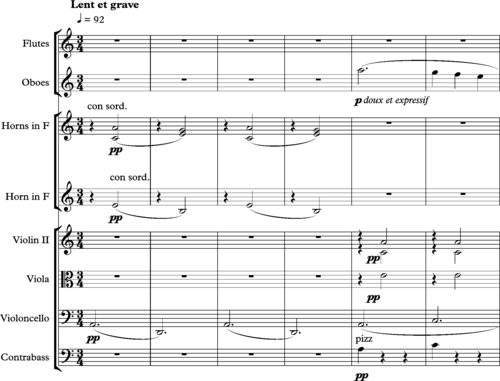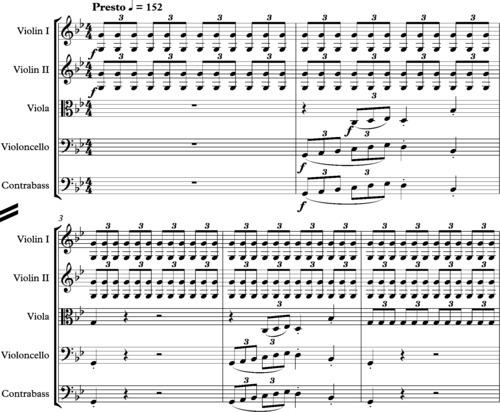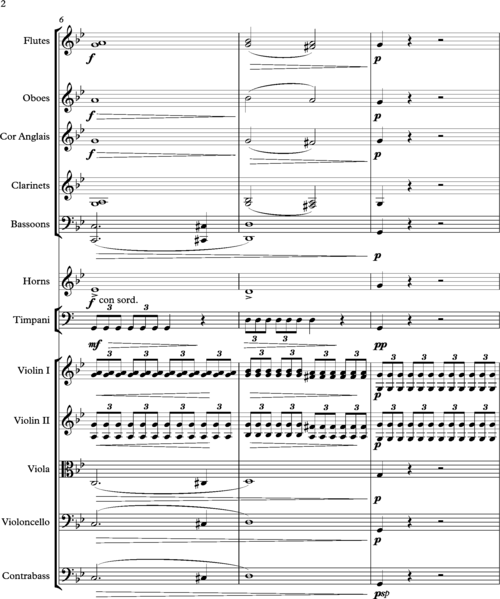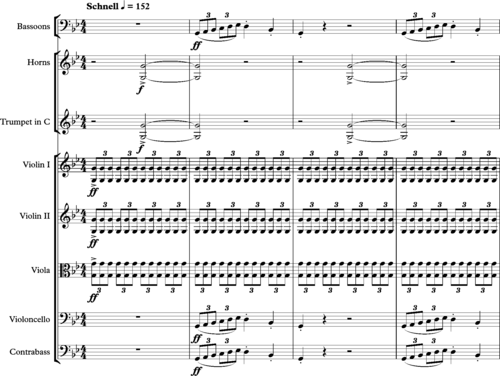Strings
The string section is a body of instruments composed of various bowed stringed instruments. By the 19th century orchestral music in Europe had standardized the string section into the following homogeneous instrumental groups: first violins, second violins (the same instrument as the first violins, but typically playing an accompaniment or harmony part to the first violins, and often at a lower pitch range), violas, cellos, and double basses. The string section in a multi-sectioned orchestra is sometimes referred to as the "string choir". [24]
The harp is also a stringed instrument, but is not a member of nor homogeneous with the violin family, and is not considered part of the string choir. Samuel Adler classifies the harp as a plucked string instrument in the same category as the guitar (acoustic or electric), mandolin, banjo, or zither. [25] Like the harp, these instruments do not belong to the violin family and are not homogeneous with the string choir. In modern arranging these instruments are considered part of the rhythm section. The electric bass and upright string bass—depending on the circumstance—can be treated by the arranger as either string section or rhythm section instruments. [26]
A group of instruments in which each member plays a unique part—rather than playing in unison with other like instruments—is referred to as a chamber ensemble. [27] A chamber ensemble made up entirely of strings of the violin family is referred to by its size. A string trio consists of three players, a string quartet four, a string quintet five, and so on.
In most circumstances the string section is treated by the arranger as one homogeneous unit and its members are required to play preconceived material rather than improvise.
A string section can be utilized on its own (this is referred to as a string orchestra) [28] or in conjunction with any of the other instrumental sections. More than one string orchestra can be utilized.
A standard string section (vln., vln 2., vla., vcl, cb.) with each section playing unison allows the arranger to create a five-part texture. Often an arranger will divide each violin section in half or thirds to achieve a denser texture. It is possible to carry this division to its logical extreme in which each member of the string section plays his or her own unique part.
Size of the string section
Artistic, budgetary and logistical concerns, including the size of the orchestra pit or hall will determine the size and instrumentation of a string section. The Broadway musical West Side Story , in 1957, was booked into the Winter Garden theater; composer Leonard Bernstein disliked the playing of "house" viola players he would have to use there, and so he chose to leave them out of the show's instrumentation; a benefit was the creation of more space in the pit for an expanded percussion section. [29]
George Martin, producer and arranger for the Beatles, warns arrangers about the intonation problems when only two like instruments play in unison: "After a string quartet, I do not think there is a satisfactory sound for strings until one has at least three players on each line ... as a rule two stringed instruments together create a slight 'beat' which does not give a smooth sound." [30] Different music directors may use different numbers of string players and different balances between the sections to create different musical effects.
While any combination and number of string instruments is possible in a section, a traditional string section sound is achieved with a violin-heavy balance of instruments.
Suggested string section sizes| Reference | Author | Section size | Violins | Violas | Celli | Basses |
|---|
| "Arranged By Nelson Riddle" [31] | Nelson Riddle | 12 players | 8 | 2 | 2 | 0 |
| 15 players | 9 | 3 | 3 | 0 |
| 16 players | 10 | 3 | 3 | 0 |
| 20 players | 12 | 4 | 4 | 0 |
| 30 players | 18 | 6 | 6 | 0 |
| "The Contemporary Arranger" [32] | Don Sebesky | 9 players | 7 | 0 | 2 | 0 |
| 12 players | 8 | 2 | 2 | 0 |
| 16 players | 12 | 0 | 4 | 0 |
| 20 players | 12 | 4 | 4 | 0 |
|















